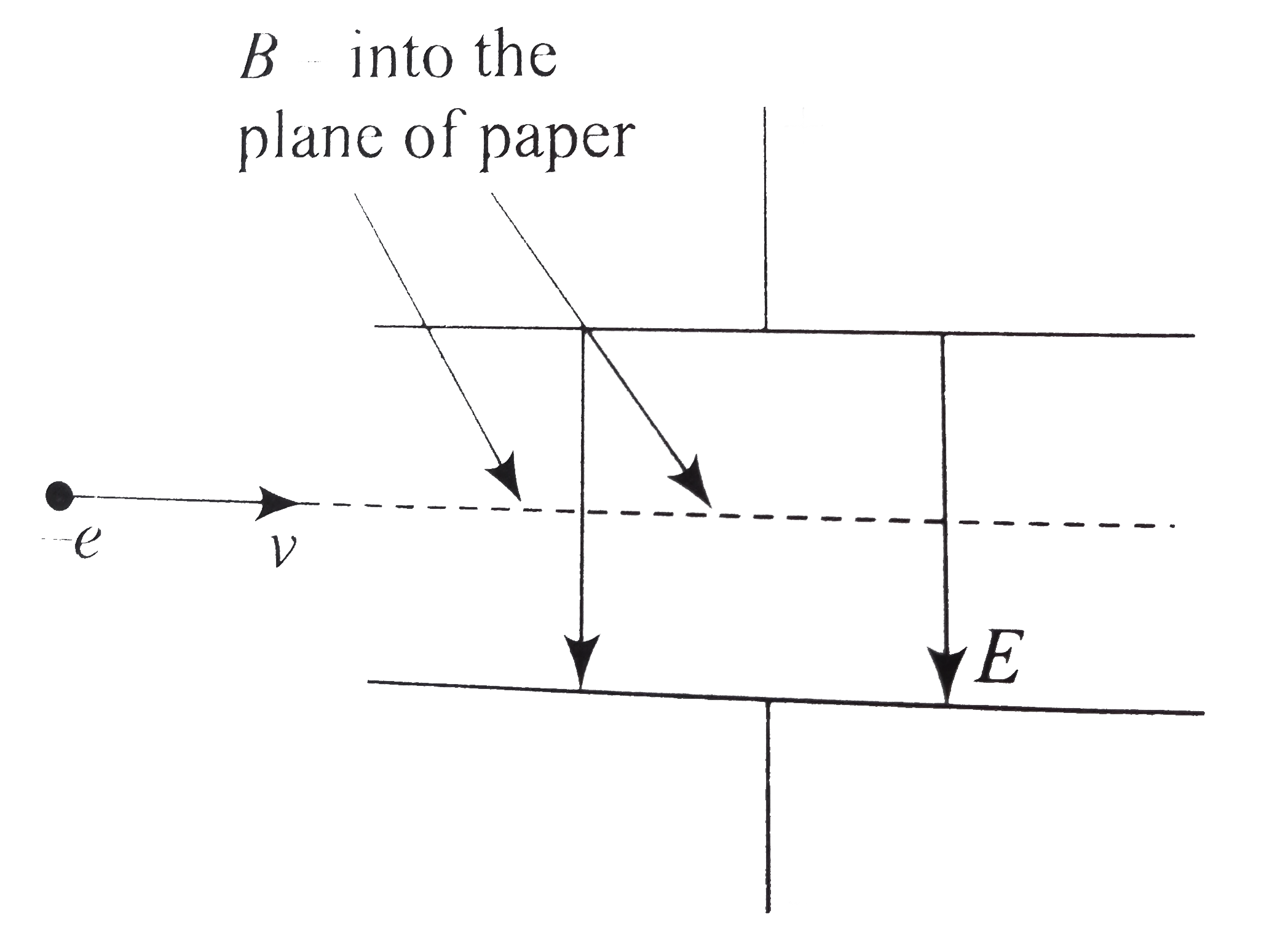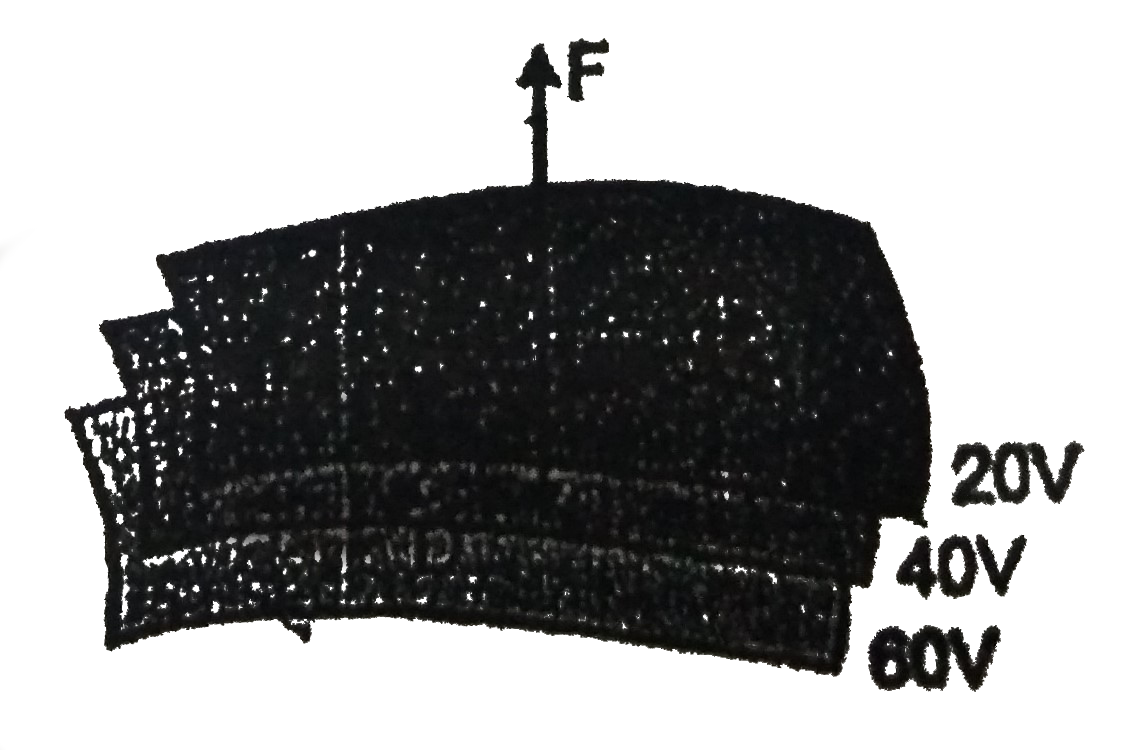An electron is moving along +x direction with a velocity of 6×106ms−1 . It enters a region of uniform electric field of 300 V/cm pointing along + y direction. The magnitude and direction of the magnetic field set up in this region such that the electron keeps moving along the x direction will be :
3×10−4T , along + z direction
5×10−3T , along - z direction
5×10−3T,along + z direction
3×10−4T , along -z direction
To solve the problem, we need to determine the magnetic field that will allow an electron moving in the positive x direction to continue moving in that direction when it enters a region with an electric field in the positive y direction.
1. Identify the Given Values:
- Velocity of the electron, v=6×106m/s (in the +x direction).
- Electric field, E=300V/cm=3×104V/m (in the +y direction).
- Charge of the electron, q=−e (where e≈1.6×10−19C).
2. Write the Force Equation:
The total force F acting on the electron is given by:
F=qE+q(v×B)
For the electron to keep moving in the +x direction, the net force must be zero:
0=qE+q(v×B)
3. Substituting the Values:
Since q=−e:
0=−eE+(−e)(v×B)
Simplifying gives:
eE=e(v×B)
We can cancel e (since e≠0):
E=v×B
4. Determine the Cross Product:
The velocity vector v is in the +x direction, which can be represented as:
v=6×106^i
Let the magnetic field B be represented as:
B=Bx^i+By^j+Bz^k
The cross product v×B is calculated as follows:
v×B=∣∣
∣
∣∣^i^j^k6×10600BxByBz∣∣
∣
∣∣
This results in:
v×B=^i(0⋅Bz−0⋅By)−^j(6×106⋅Bz−0)+^k(6×106⋅By−0)
Simplifying gives:
v×B=−6×106Bz^j+6×106By^k
5. Setting the Forces Equal:
Now we have:
E=−6×106Bz^j+6×106By^k
Since E is in the +y direction, we can equate the components:
- For the y-component:
E=−6×106Bz
Since E=3×104:
3×104=−6×106Bz⟹Bz=−3×1046×106=−0.5×10−2T
- For the z-component:
0=6×106By⟹By=0
6. Final Result:
The magnetic field has no component in the y-direction and a negative component in the z-direction:
B=0^i+0^j−0.5×10−2^kT
Thus, the magnitude of the magnetic field is:
|B|=5×10−3T along the negative z direction.
Conclusion:
The magnitude and direction of the magnetic field required for the electron to continue moving in the +x direction is 5×10−3T along the -z direction.
- Velocity of the electron, v=6×106m/s (in the +x direction).
- Electric field, E=300V/cm=3×104V/m (in the +y direction).
- Charge of the electron, q=−e (where e≈1.6×10−19C).
The total force F acting on the electron is given by:
F=qE+q(v×B)
For the electron to keep moving in the +x direction, the net force must be zero:
0=qE+q(v×B)
Since q=−e:
0=−eE+(−e)(v×B)
Simplifying gives:
eE=e(v×B)
We can cancel e (since e≠0):
E=v×B
The velocity vector v is in the +x direction, which can be represented as:
v=6×106^i
Let the magnetic field B be represented as:
B=Bx^i+By^j+Bz^k
The cross product v×B is calculated as follows:
v×B=∣∣
∣
∣∣^i^j^k6×10600BxByBz∣∣
∣
∣∣
This results in:
v×B=^i(0⋅Bz−0⋅By)−^j(6×106⋅Bz−0)+^k(6×106⋅By−0)
Simplifying gives:
v×B=−6×106Bz^j+6×106By^k
Now we have:
E=−6×106Bz^j+6×106By^k
Since E is in the +y direction, we can equate the components:
- For the y-component:
E=−6×106Bz
Since E=3×104:
3×104=−6×106Bz⟹Bz=−3×1046×106=−0.5×10−2T
- For the z-component:
0=6×106By⟹By=0
The magnetic field has no component in the y-direction and a negative component in the z-direction:
B=0^i+0^j−0.5×10−2^kT
Thus, the magnitude of the magnetic field is:
|B|=5×10−3T along the negative z direction.
The magnitude and direction of the magnetic field required for the electron to continue moving in the +x direction is 5×10−3T along the -z direction.
Topper's Solved these Questions
Similar Questions
An electron with kinetic energy 2.5 keV moving along the positive direction of an x axis enters a region in which a uniform electric field of magnitude 10 kV/m is in the negative direction of the y-axis. A uniform magnetic field →B is to be set up to keep the electron moving along the x-axis , and the direction →B of is to be chosen to minimize the required magnitude of →B. In unit-vector notation, what →B should be set up?
View SolutionIf an electron enters a magnetic field with its velocity pointing in the same direction as the magnetic field, then
View Solution
Knowledge Check
Assertion : In a uniform electric field electrons move in the opposite direction of electric field.
Reason : This is because of the negative charge of an electron.AIf both assertion and reason are true and reason is the correct explanation of assertion.BIf both assertion and reason are true but reason is not the correct explanation of assertion.CIf assertion is true but reason is false.DIf both assertion and reason are false.

Electrons taveling at a velocity of 2.4×106ms−1 enter a region of crossed electric and magnetic fields as shoen in Fig. If the electric field is 3.0×106 Vm and the flux density of the magnetic field is 1.5 T, the electrons upon entering the region of the crossed fields will
View SolutionA proton is moving with a velocity of 5×105m/s along the Y-direction. It is acted upon by an electric field of intensity 105 V/m along the X-direction and a magnetic field of 1Wb/m2 along the Z-direction. Then the Lorentz force on the particle is :
View SolutionA family of equipotential surface are shown. The direction of the electric field at point A is along-

View SolutionA uniform electric field and a uniform magnetic field are acting along the same direction in a certain region. If an electron is projected along the direction of the fields with a certain velocity then
View SolutionA uniform electric field and a uniform magnetic field are acting along the same direction in a certain region. If an electron is projected along the direction of the fields with a certain velocity then
View SolutionA uniform electric field and a uniform magnetic field are acting along the same direction in a certain region. If an electron is projected along the direction of the fields with a certain velocity then
View SolutionA uniform electric field and a uniform magneitc field exist in a region in the same direction An electron is projected with velocity pointed in the same direction the electron will
View Solution
